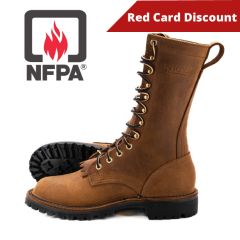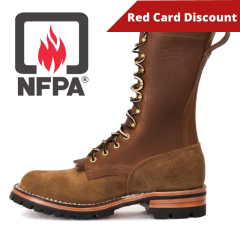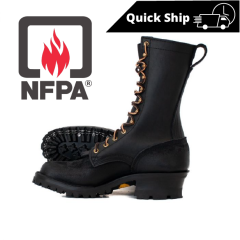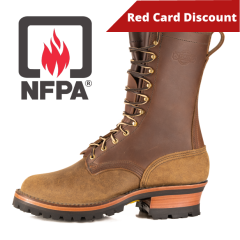Best Fire Boots: Protection And Durability
Key Takeaways:
- NFPA-Certified Fire Boots: They offer essential protection from heat, electrical hazards, and punctures and meet the highest safety standards for firefighters.
- Durability And Rebuildability: Core features of Nicks Boots fire boots, ensuring long-term use with options for sole replacement and repairs.
- Proper Fit: Crucial for both protection and prolonging the life of fire boots, ensuring comfort, safety, and reduced wear in hazardous conditions.
Understanding NFPA Certification For Fire Boots
The NFPA (National Fire Protection Association) certification is a central standard for fire boots, ensuring they meet stringent safety guidelines, and protect firefighters when it counts. Fire boots with this certification must undergo rigorous testing for fire resistance, water penetration, and durability against extreme conditions such as high heat, sharp objects, and uneven surfaces. NFPA-certified boots are built to minimize risks and maximize protection, providing wearers with confidence in the field.
For a fire boot to earn this certification, it must also pass tests for slip resistance, puncture resistance, and electrical hazard protection. These safety measures are crucial for professionals who regularly face unpredictable environments, like firefighters. Investing in NFPA-certified boots ensures users choose qualified footwear – meeting industry standards and offering superior protection in the harshest work conditions.
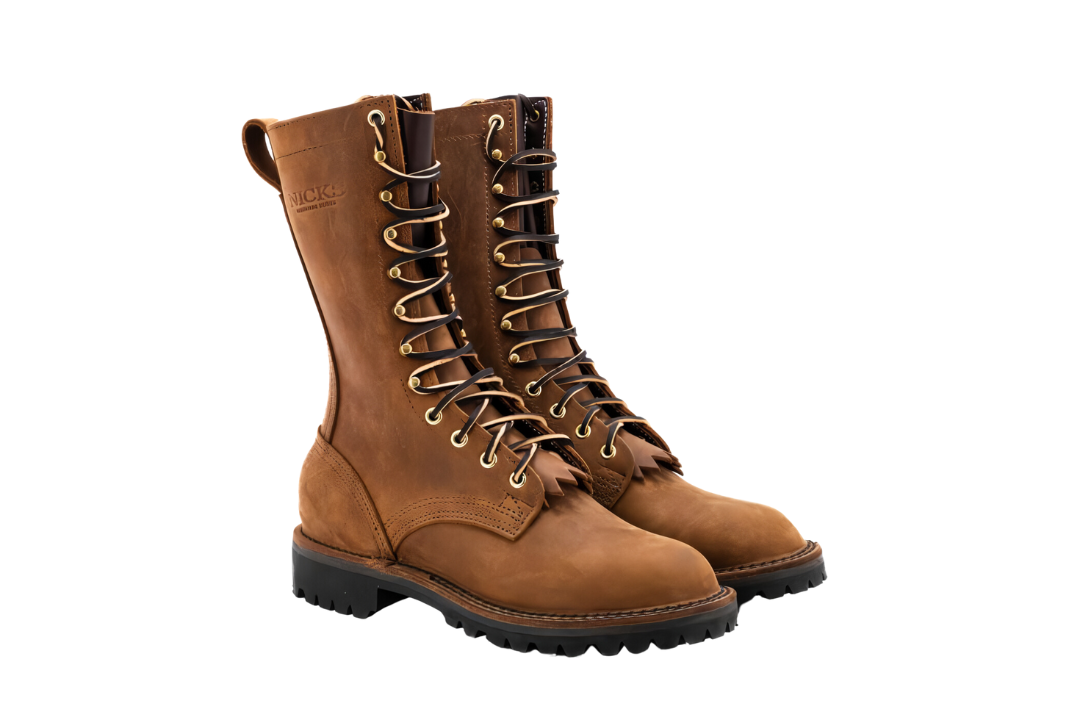
Protective Standards: What Makes A Fire Boot Safe?
Heat Resistance: Essential Protection Against Extreme Temperatures
Fire boots must offer superior heat resistance to protect wearers from the intense heat they encounter in wildfires or structural fires. The materials used in these boots, such as leather, must withstand prolonged exposure to extreme temperatures without degrading. This heat resistance is critical in preventing burns or other heat-related injuries. At Nicks Boots, we use fire-resistant stitching and Vibram soles designed to handle the heat while maintaining the boot’s integrity.
Puncture Resistance: Safeguarding Against Sharp Hazards
Firefighters often encounter hazardous environments with sharp debris, such as broken glass, metal, or nails. Puncture-resistant soles prevent these objects from penetrating the boot and injuring the wearer’s foot. Fire boots with thick, puncture-resistant materials ensure maximum protection from ground hazards. This feature is especially important during rescue operations in unstable environments. Without puncture-resistant soles, the risk of foot injuries dramatically increases, impacting safety and performance.
Slip Resistance: Stability In Unpredictable Terrain
Firefighters often operate on slippery, uneven, or unstable terrain, making slip resistance an essential feature in fire boots. Durable slip-resistant soles, typically made from materials like Vibram, offer superior traction on wet, oily, or debris-covered surfaces. Ensuring fire boots have high-quality, slip-resistant soles minimizes the risk of falls and injuries, allowing firefighters to move confidently in unpredictable conditions.
Electrical Hazard Protection: Guarding Against Electrical Shocks
Fire boots must offer electrical hazard protection in environments where electrical hazards are present, such as during urban firefighting. This means the soles of the boots must insulate the wearer from electrical currents, reducing the risk of electrocution. At Nicks Boots, our fire boots are built with this safety feature, adhering to NFPA standards. Electrical hazard protection is especially important when working around live wires or damaged electrical equipment. Without it, firefighters could be more vulnerable to life-threatening risks in the line of duty.
Fire-Resistant Materials: Building Long-Lasting Safety
The materials used in fire boots are vital for ensuring both safety and durability. Premium, fire-resistant leather, and stitching allow the boots to endure heat and heavy wear. Crafted from top-grade leather, these fire boots offer exceptional durability and fire resistance, maintaining their protective qualities even after prolonged use in tough conditions. Choosing boots made from high-quality materials is vital to ensuring long-term safety and reliable performance.
Top Recommendations For Fire Boots With Superior Protection And Durability
FireTrooper® – Red Card Wildland Fire Boots
The FireTrooper® wildland firefighting boot is built for rugged terrain and extreme conditions. Its water-resistant rubber construction, paired with a red-x unit lug outsole, delivers exceptional traction and durability in challenging environments. Lightweight yet tough, this boot can withstand the demands of the job while keeping you steady on your feet. The rubber insole and midsole offer excellent cushioning and shock absorption, ensuring comfort during extended shifts. With these features, the FireTrooper® provides both reliability and comfort for wildland firefighters.
Hot Shot® Moderate Arch – Red Card Wildland Fire Boots
This is our core National Fire Protection Agency (NFPA) certified fire boot, rigorously tested by third parties for heat, puncture, and slip resistance. Featuring a burn-resistant Vibram® "RedX" lug sole and burn-resistant stitching, it’s built to endure extreme conditions. Each boot is made from the same hide, with a rough-out toe and heel and a smooth upper for added durability. With a 1" sole stack, legendary arch support, and 7.5 to 8 oz leather, it offers unmatched comfort and toughness on rugged terrain. Handmade in the USA, this 10" boot is rebuildable and resolable for long-lasting performance.
Hot Shot® Classic Arch Logger Heel – Red Card Wildland Fire Boots
The Hot Shot® Classic Arch Logger Heel boots are ideal for firefighters needing superior arch support and stability. Featuring a classic logger heel and high-quality leather, these boots are designed to withstand the harshest conditions. They come equipped with a burn-resistant Vibram® "RedX" lug sole and burn-resistant stitching for added durability. Like other models, they are NFPA-certified and rebuildable, making them a durable, long-term investment for wildland firefighting.
Caring For Your Fire Boots To Maximize Their Lifespan
Cleaning Your Fire Boots: Removing Dirt And Debris
Regular cleaning is vital for extending the life of your fire boots. Dirt, ash, and debris can degrade the leather and stitching if left unattended. Use a soft brush or a damp cloth to gently remove any buildup from the surface. Avoid harsh chemicals, as they can damage the boot’s materials, compromising its durability. Routine cleaning ensures the boots maintain their protective qualities and appearance, making them last longer and ready for every mission.
Conditioning The Leather: Preventing Cracks And Dryness
Leather fire boots need periodic conditioning to stay flexible and durable. Apply a high-quality leather conditioner to keep the material soft and resistant to cracking from heat and exposure to harsh environments. Conditioning helps maintain the boot's water-resistant properties and ensures the leather doesn’t become brittle over time. It also improves comfort, as well-conditioned leather molds to the wearer’s foot. Regular conditioning protects the investment and preserves both the look and functionality of the boots.
Proper Storage: Protecting Against Moisture And Damage
Proper storage is crucial to preserving the integrity of your fire boots when not in use. Store the boots in a cool, dry environment to prevent moisture from damaging the leather and the soles. Exposure to damp areas can lead to mold growth, while heat sources like radiators can dry out the leather and cause it to crack. Boots should also be kept upright to maintain their shape. Effective storage practices keep the boots in optimal condition and ready for the next mission.
Rebuildability: Extending The Life Of Your Boots
Nicks Boots are rebuildable, allowing you to extend the life of your fire boots beyond typical wear and tear. Over time, even the best boots may require new soles or repairs to maintain peak performance. Rather than buying new boots, Nicks Boots offers a rebuild service where worn parts can be replaced, including stitching and leather restoration. This sustainable option maximizes your initial investment, providing boots that feel brand new while reducing waste. Rebuildability ensures your boots remain reliable for years.
How Proper Fit Affects Fire Boot Protection And Durability
Support And Comfort: Preventing Foot Fatigue
A well-fitted fire boot provides essential support, reducing foot fatigue during long shifts in demanding conditions. Firefighters are on their feet for hours, often in rough terrain, and a poorly fitting boot can cause discomfort and pain. Proper arch and ankle support prevent unnecessary strain, allowing for more comfortable movement. The right fit ensures that firefighters can focus on their tasks without being distracted by discomfort.
Injury Prevention: Avoiding Blisters And Foot Damage
When fire boots don’t fit properly, they can cause blisters, hot spots, and other injuries. Too loose boots allow for excess movement inside, leading to friction that can damage the skin. On the other hand, boots that are too tight can restrict blood flow and cause discomfort. Properly fitted boots eliminate these risks, ensuring the wearer’s feet remain protected from external and internal factors.
Enhancing Protective Features: Staying Secure In Hazardous Environments
A proper fit is essential for maximizing the protective features of fire boots. Well-fitting boots provide better stability and grip – crucial for unpredictable or slippery terrain. Loose boots can compromise traction, increasing the risk of slips or falls. A secure fit ensures that puncture resistance and slip protection work as intended.
Durability Through Proper Fit: Prolonging The Life Of Your Boots
Boots with a correct fit are less likely to experience premature wear and tear. This is because a snug fit helps evenly distribute the wear across the boot, preventing stress on specific areas like the soles or leather. Boots that are too loose tend to break down faster due to uneven pressure, especially in high-stress areas. Proper fit extends the boot's life, making it a better long-term investment.
Read also:
- Classic Cowboy Boots vs. Roper Boots: What's The Difference?
- Combat Boots vs. Tactical Boots: A Comprehensive Guide
- Pull-On Boots vs. Lace-Up Boots: A Detailed Comparison
Frequently Asked Questions About Fire Boots
What makes fire boots different from regular work boots?
Fire boots are designed with special materials, such as heat-resistant leather and fire-resistant stitching, to withstand extreme temperatures, hazardous conditions, and rough terrain. Regular work boots typically lack these protective features.
Why is NFPA certification important for fire boots?
NFPA certification ensures fire boots meet safety standards for protection against heat, puncture, and electrical hazards, providing critical protection for firefighters in dangerous environments.
How do fire boots provide heat resistance?
Fire boots use materials like specially treated leather and fire-resistant stitching to protect the wearer from extreme temperatures. The soles are also designed to withstand high heat without melting or degrading.
What kind of soles should fire boots have for durability?
Fire boots typically feature Vibram® soles or similar durable rubber compounds that offer superior grip, puncture resistance, and durability on rough, uneven surfaces.
Do fire boots protect against electrical hazards?
Yes, fire boots often come with electrical hazard protection, which insulates the wearer from electric currents, reducing the risk of electrocution when working near live wires.
How do you care for fire boots to maintain their durability?
Fire boots should be regularly cleaned with a soft brush and conditioned to keep the leather supple. Proper storage in a cool, dry place is essential to prevent damage.
Can fire boots be resoled or rebuilt?
Yes, high-quality fire boots like those from Nicks Boots are rebuildable, allowing you to replace worn parts like the sole and extend the boot's life.
Why is puncture resistance important in fire boots?
Firefighters often work in environments with sharp debris, such as nails and broken glass. Puncture-resistant soles prevent these hazards from penetrating the boot and injuring the foot.
What role does fit play in the durability of fire boots?
A properly fitting fire boot evenly distributes pressure and wear, reducing stress on specific areas and prolonging the boot’s overall lifespan.
How long do fire boots typically last?
With proper care and rebuilds, fire boots can last several years, making them a worthwhile investment for firefighters who need reliable protection.
